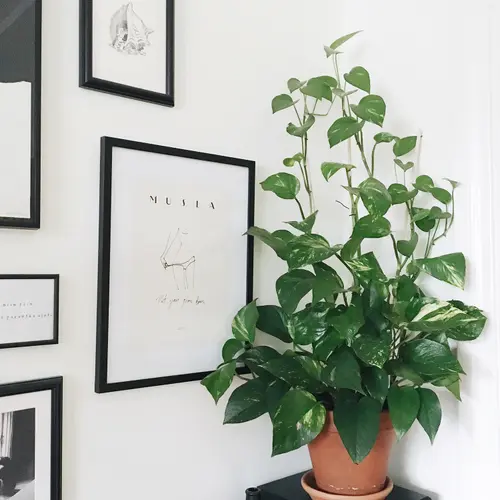Turn an easy-care houseplant into a dramatic climbing garden

Photo courtesy of Jamie Song
6sqft’s series Toolbox Tutorials shares step-by-step guides for simple, affordable DIY projects. This week, plant experts teach us how to make an easy, indoor climbing garden. Have a project you’d like to share? Get in touch with us at [email protected].
Bold botanical wallpapers are all the rage. But with a little sunlight and some patience, apartment dwellers can create a graphic pattern that literally climbs the walls (or ceiling!). The humble pothos (Epipremnum aureum), a staple of office and mall decor thanks to its easy-care nature, is the ideal trailing specimen to train indoors. It grows quickly, it thrives in indirect light, and its heart-shaped leaves aren’t accompanied by clinging parts that could damage surfaces (and bite into your deposit refund). Read on for instructions on creating and maintaining your own climbing garden from some of Instagram’s top plant lovers.
 Courtesy Jamie Song
Courtesy Jamie Song
Jamie Song, the indoor plant enthusiast behind the enviable @jamies_jungle Instagram account, guides his neon variety of pothos into an elegant vase shape behind the sofa in his southeast London flat. He supports the wax-smooth tendrils with clear, adhesive-backed hooks by Command —intended for mounting holiday lights—because they’re subtle and removable.
Song’s apartment, a converted power station built in 1902, features a grand original skylight. But a pothos will settle for a standard window nearby. “Some direct sun is good, but not all-day direct sun,” he says. “Water when the soil has dried,” he adds. He uses a self-watering pot to minimize that chore.
 Courtesy of Anni Koskimies
Courtesy of Anni Koskimies
If you want a wall-swallowing pothos, prepare to invest a couple of years. But money is a different matter. A potted pothos from a hardware store or nursery will set you back only about $15 to $30, depending on the size.
If you have patience in spades, you can grow a pothos for free by starting with a snipped stem. “Almost all my [pothos plants] are grown from cuttings of my older plants,” says Anni Koskimies, creator of the ironically named Instagram account @nomoreplants. “Before taking the cutting, I make sure there are a few leaves and a root node [a fingerlike projection on the stem].” Next, she removes the leaf closest to the cut end and suspends the stem in a glass of water, which stimulates white roots to form. When they’re an inch long, she plants the cutting in all-purpose potting soil.
 Courtesy of Anni Koskimies
Courtesy of Anni Koskimies
Koskimies, a student at Lahti Institute of Design in Finland, likes to take a pothos vertical by tying the stems to thin wooden stakes, available at hardware and art supply stores. For more organic climbing compositions, she lays branches on brass picture hangers hung with double-sided tape instead of nails to preserve her walls.
 Courtesy of Mike Vorrasi for Wallpaper Projects
Courtesy of Mike Vorrasi for Wallpaper Projects
On this side of the pond, a pothos of epic proportions grows in Brooklyn. “[My plant has] been with me for seven years, and it was only about 36 inches tall when it came home. Now the longest branch expands more than 50 feet,” says David Jimenez, co-founder of Wallpaper Projects.
He initially trained his specimen, a “rescue” from the street in Chinatown, to undulate overhead by resting its branches on loops of red string tied to his sprinkler pipes. The plant rapidly outgrew those confines, so “I hung a system of strings that expands over almost the whole ceiling at the apartment, and that gives me the freedom to keep going for a lot more years, I hope,” he says.
“The tendrils get rearranged every six months or so as we start bumping into them, or they get in the way of us watching TV,” Jimenez continues. He plucks off any dry leaves once a week, and he feeds once a year with an all-natural fertilizer called Houseplants Alive!, available from the website Gardens Alive!
 Courtesy Jamie Song
Courtesy Jamie Song
“David is a plant whisperer,” says Amanda Dandeneau, his partner in business and life. But the truth is, you don’t need special abilities or even a greenish thumb to grow a monster pothos. Here’s everything you need to know to maintain and train one:
Light: Low to bright indirect sun
Water: Soak thoroughly when the soil feels dry a finger’s length down.
Medium: All-purpose potting soil
Feeding: Fertilize once a year at minimum to maintain the soil’s natural balance and texture
Training: A pothos won’t climb on its own, so use a removable support system to guide its tendrils along a wall or ceiling. Command hooks, metal picture hangers, and string work well.
RELATED:



































